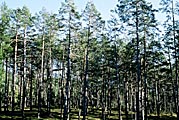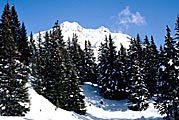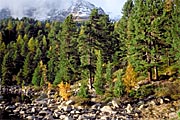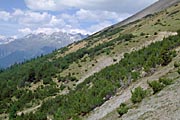 |
|
|
|
|
|
|
Swiss Alpine forest communities In the high-montane and subalpine zone with its typical site characteristics, specific forest communities occur. Every forest community is characterized by its forest-building tree species (link to the glossary) and by some characteristic herbs, ferns and mosses. Only a few specialized tree species climb to the high-montane and subalpine zone and build forest communities there. Some single pioneer trees occasionally occur in these zones as well, but they are not forest-building tree species. We call these occasionally occurring tree species (link to the glossary). The forest limit is formed by coniferous tree species of the subalpine zone in most regions of the Swiss Alps. Only in a few regions can we also find stands of deciduous trees at the forest limit. Due to the mixture of tree species in a forest we differentiate three types of forests:
In the list below, the most important forest-building trees of
the high-montane and subalpine zone are described. The occurrence of these
tree species depends on different altitudinal and physiological limits.
Some tree species grow as a kind of dwarf shrubs at the so called Krummholz
limit. |
Fagus sylvatica (beech):
|
1 - Beech (Fagus sylvatica) and silver fir (Abies alba) forming a high-montane forest in the Northern Alps and Jura mountains (Switzerland). |
|
Abies alba (silver fir):
|
2 - Silver fir (Abies alba) - Norway spruce (Picea abies) forest in the Swiss Plateau (Canton of Aargau, Switzerland). |
Pinus sylvestris (Scots pine):
|
3 - Montane Scots pine (Pinus sylvestris) forest (Weissenstein, Southern Tyrolian Alps). |
Picea abies (Norway spruce):
|
4 - Subalpine Norway spruce (Picea abies) forest during winter (San Bernardino, Lago Dosso, Grisons, Switzerland). |
|
Larix decidua (European larch):
|
5 - Group of European larches (Larix decidua) growing in the subalpine zone (Val Müstair, Grisons, Switzerland). |
|
Pinus cembra (Alpine stone pine):
|
6 - Alpine stone pine (Pinus cembra) forming a subalpine coniferous forest together with European larch (Larix decidua) in yellow autumn coloration (Val di Camp, Grisons, Switzerland). |
Pinus mugo ssp. uncinata (mountain pine):
|
7 - Mountain pine (Pinus mugo ssp. uncinata) forming subalpine single species forests (Ofenpass, Grisons, Switzerland). |
|
Pinus mugo ssp. mugo (dwarf mountain pine):
|
8 - Dwarf pine (Pinus mugo ssp. mugo) building the krummholz zone at the tree limit on dolomitic screes (Munt la Schera, Grisons, Switzerland). |
|
|
In the following interactive animation, use the above clues to create one or more examples of the 8 most important forest communities in the upper-montane and subalpine zone of the Swiss Alps. Click on one or more trees (symbols) from the available species to "plant" it in the box below, if you think that it could be a forest-building tree in the community you are creating. Try to choose realistic combinations. Clicking on the trees within the box will remove them from the community. Click the check button to see if your self-created community is possible and get more information about it. Click the reset button to try again. |
29 August 2011 |
||
| |
||







